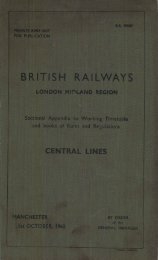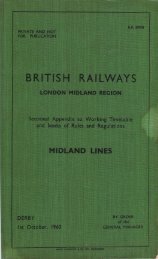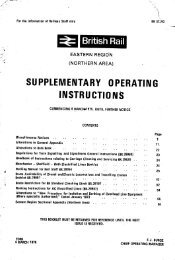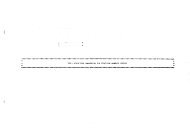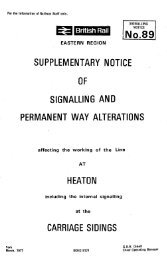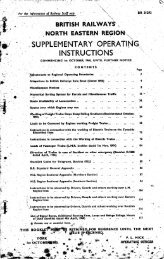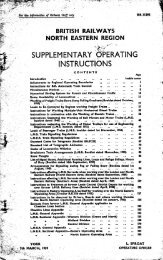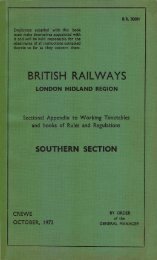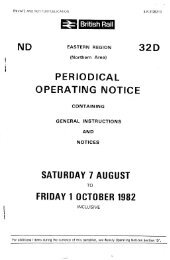general instructions. - Limit Of Shunt
general instructions. - Limit Of Shunt
general instructions. - Limit Of Shunt
Create successful ePaper yourself
Turn your PDF publications into a flip-book with our unique Google optimized e-Paper software.
178 G e n e r a l 'Nnstructions.---Continued.<br />
SIGNALLING ifi". LIGHT ENGINES 1N:TH SECOND TENDER ATTACHED. -<br />
General Rules 207 (14) and B.T.R.<br />
A light engine with a second tender attached must be signalled on the<br />
block bell as light engines coupled, viz., 2 pause 3. The Locomotive Department<br />
will in all cases provide a man with hand signals and detonators to<br />
ride on the second tender. ( O . 2593).<br />
TRANSIT OF ANIMALS.<br />
General Rule 210.<br />
1.—Care must be taken from time to time to see that the animals are<br />
travelling safely, and if any are found to be down in the wagons, steps<br />
must be taken to have them put right as soon as possible, and a note of the<br />
occurrence must be made on the guard's journal. •<br />
2—Guards of Freight trains must shew at the foot of their journals tohe<br />
number of wagons loaded with live stock which are conveyed by their<br />
trains and the points at which the wagons are attached and detached.<br />
When horse boxes or special cattle boxes are conveyed on goods trains,<br />
guards must distinguish them from other live stock vehicles.<br />
When trains consist entirely of live stock, it will suffice if the total number<br />
of vehicles of each class is given, i.e., horse boxes, special cattle boxes, and<br />
eattle trucks. ( O . 4500).<br />
3.—Guards must take special care of the documents handed to them in<br />
connection with live stock sent by their trains, and must give all such documents<br />
to the proper person at the place where they detach the wagons.<br />
HORSES AND OTHER L:VE STOCK FOR ROADSIDE sTATIoNs<br />
BY NIGHT.<br />
General Rule 210.<br />
1.—Except by previous arrangement with the receiving station, no horses<br />
or other live stock must be sent to any station unless they will arrive while<br />
there is attendance at the signal box at that station. If the station is one at<br />
which the hours of attendance are not given, live stock must only be sent so<br />
as to arrive at or between the hours at which the first morning and last<br />
evening trains are shown in the working time table to stop at such station<br />
and, if, from special or unforseen detention on the road, the guard finds<br />
that the train cannot arrive at the station at or between those hours, he<br />
must decide at which nearest station (where there is attendance) he will leave<br />
the live stock, and instruct the driver accordingly.<br />
When an arrangement is made to detach live stock at night at stations<br />
.after block working has ceased for the day, the Station Master must arrange<br />
for the attendance of the signalman.<br />
2.—In order to ensure live stock reaching their destination as early as<br />
possible, they may, when desirable, be sent to the nearest station thereto<br />
at which there is attendance, or when an earlier arrival can be secured by<br />
means of a train from the opposite direction, they may be sent to the nearest<br />
station beyond their destination at which there is attendance, and brought<br />
back, but no charge must be made for the extra distance they are so conyeyed.:<br />
In such cases the guard of the train must, before starting, be distinctly




